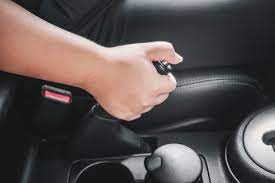If you ever feel while driving that the brakes are not as responsive as they usually are, it might be a sign that they’re going to fail. This may happen for a variety of reasons, so be sure to get your car checked here regularly to avoid situations like these. However, if the brakes do fail, stay calm and follow these 4 steps to ensure a safe halt with minimal damages:
Subscribe To The GoMechanic YouTube Channel
-
Try Pumping the Brake Pedal
A lot of times, hydraulic brakes start working again if you pump them. To do this, start by gently pressing the brake pedal at first and check if it is working. If it does work, then after a few pumps, your car will start slowing down. Remember to be gentle with the pumps, only then will you give the brake fluid a chance to work through.

-
Use the Emergency Hand Brake
Every car has an emergency hand brake, it is usually placed right behind the gear lever. To engage it, you need to push the button on it and lift it up. Now if the brakes are failing, you need to be careful and slowly lift the emergency brake. If you rip open the brake lever then your car will lose traction and it might drift off the road. So try lifting the emergency brake lever slowly and let your car come to a gradual halt. If your car has an automatic parking brake, then you will need to engage and disengage the brake repeatedly. In simple words, you’ll need to keep pressing the button and turning the brake on and off till your car comes to a halt.

Also read- 10 Common Car Noises and their Diagnosis
-
Shift down the gears one by one
If the emergency brake also doesn’t work, do not panic, we still have a solution. Take your foot off the accelerator and start shifting down the gears one by one. Your car will use something called ‘Engine Braking’ and decrease its speed automatically as you keep lowering the gears. If you have an automatic, put your car in manual mode and shift down using the lever/paddle shifters. If your automatic car does not have a manual mode, then make sure your car is in a relatively empty lane and just leave the accelerator. The gearbox will shift down automatically as the speed lowers.

-
DO NOT turn the engine off
If you turn the engine off, the access to all electronics will be shut off, including the steering wheel, stability controls, traction control, etc. This can cause some major mishaps, so make sure to keep the engine running no matter what.
Related- Signs of a Failing Alternator
These 4 steps will most definitely help you in slowing down your car, but the most important thing is to stay calm and be present in the moment. Try to keep your car away from obstacles as much as you can, don’t steer too sharply or you might lose traction. Most importantly, try to avoid this situation by keeping an eye on your car’s maintenance regularly. Make sure all the parts required for braking are functioning properly. To get the best quality brake pads, fluids and all other parts, click here.






